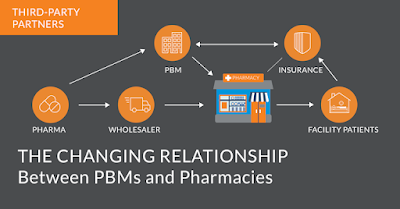By: Ranier Simons, ADAP Blog Guest Contributor
An undeniable fact with largely universal consensus is that the United States needs healthcare reform. Healthcare reform is an overhauling of the healthcare system to achieve what the Institute for Healthcare Improvement describes as the Triple Aim: “improving the patient experience of care (including quality and satisfaction), improving the health of populations, and reducing the per capita cost of health care.”[1] The Affordable Care Act (ACA) is the most recent attempt to reach the Triple Aim by increasing insurance access, mandating levels of quality, and trying to make healthcare more affordable. The challenge of healthcare reform is that healthcare is a system. By definition, a system has moving components that not only move independently but also are interdependent upon other parts of the system. Regarding healthcare, the moving parts of the system are smaller systems. South Carolina recently attempted to make some positive changes to the healthcare infrastructure in that state, though it is unclear if all the changes will actually benefit patients.
 |
| Photo Source: Greenville Legal |
It is important to remember that regulation is one tool used to attempt the improvement of the many U.S. healthcare system components. Through legislative regulation, lawmakers try to create frameworks to optimize how various healthcare system component’s function. A significant component of healthcare is prescription medication. Pharmacies, pharmacy benefit managers (PBMs), and insurance plans are several players in the prescription medication system. Presently, the costs and availability of drugs are primarily controlled by PBMs. Insurance companies employ pharmacy benefit managers who control which drugs appear on plan formularies, negotiate the prices insurance plans pay for prescriptions, decide which pharmacies can participate in a plan’s network, and more.[3,5]
While many components within the U.S. healthcare system operate under detailed and enforced regulation, PBMs do not. They are largely unregulated. To maximize their profits, they participate in multiple practices that create challenges for insurance plans, pharmacies, and ultimately patients, driving up costs and creating inefficiencies in patient care.[3,5] South Carolina has been working through legislation to curtail and regulate the activity of PBMs - including Senate Bill 520 (SB520), part of the Pharmacy Audit Protection Act - which was recently passed by the state legislature.[2]
One of many excessive practices by PBMs to drive profit is pharmacy audit. A pharmacist with over 30 years experience providing care to patients living with HIV/AIDS summarized, “Pharmacists are constantly being audited by strong-arm PBMs. They often go after the high-cost drugs and deny claims for minor infractions. It’s a bullying tactic.” SB520 aims to protect pharmacies from unjust audits by PBMs. The bill defines explicitly the structure of what entity can be designated a PBM; it explains what PBMs operationally can and cannot do, defines the rights of pharmacies in general and in the face of a PBM audit, gives patients freedom of choice in utilizing in-network pharmacies, and much more. PBMs use numerous abusive audit practices to drive profit, including audit fees, denying claims for minor clerical errors forcing pharmacies to pay back money for drugs they were reimbursed, and making it difficult for pharmacies to re-bill PBMs after winning audit appeals.
 |
| Photo Source: Framework LTC |
The bill is essentially a step in the right direction. However, multiple payers lobbied to add verbiage potentially adversely affecting HIV patients and others. Section 38-71-2245, subsection (A) states: “A pharmacy benefits manager may neither limit an insured from selecting an in-network pharmacy or pharmacist of the insured's choice nor deny the right of a pharmacy or pharmacist to participate in a network if the pharmacy or pharmacist meets the requirements for network participation set forth by the pharmacy benefits manager, and the pharmacy or pharmacist agrees to the contract terms, conditions, and rates of reimbursements.”[2] This section protects patient choice of pharmacists.
Payers asked for the following verbiage added to the section:
“Notwithstanding subsection (A), a pharmacy benefits manager may, for specialized delivery drugs, specify requirements for network participation that: (1) directly relate to the ability of the pharmacy or pharmacist to store, handle, or deliver a prescription drug in a manner that ensures the quality, integrity, or safety of the drug, its delivery, or its use; or (2) relate to quality metrics that affect a pharmacy's or pharmacist's ability to participate, provided that the pharmacy benefits manager applies such terms equally to all network participants. (C) For prescription drugs that qualify as a high-cost prescription drug, subsection (A) of this section does not apply to a pharmacy benefits manager. A high-cost prescription drug is defined as a prescription drug whose current or prior year's annual average wholesale price exceeded 300 percent of the Federal Poverty Level for a single-member household. (D) A pharmacy benefits manager must provide notification of any changes to all applicable specialized delivery drug lists and high-cost prescription drug lists and must make such lists available on a website and upon request to participating pharmacies. A pharmacy may appeal a classification determination to the Department of Insurance.”[2]
The verbiage states that patient choice protections do not apply to specialty or high-cost prescription drugs. In section 38-71-2200, the bill defines specialized delivery drugs as “a prescription drug that meets a majority of the following criteria, as set forth by the manufacturer, FDA, or other applicable law or regulatory body and: (a) requires special handling or storage; (b) requires complex and extended patient education or counseling; (c) requires intensive monitoring; (d) requires clinical oversight; or (e) requires product support services; and the drug is used to treat chronic and complex, or rare medical conditions (i) that can be progressive; or (ii) that can be debilitating or fatal if left untreated or under-treated.”[2]
Given the broad definition of specialty and high-cost prescription drugs, the bill allows PBMs to manipulate how HIV antiretrovirals and related treatments are filled. The pharmacist consulted on this issue also explains, "It’s a way for PBMs to mandate that these prescriptions need to be filled from their central mail pharmacies. Since most HIV ARVs are oral and do not require special handling, access has commonly been allowed at retail. The high cost is what’s driving this change. Also, most independent pharmacies don’t mind not having to fill these drugs because of the high cost. For HIV-focused pharmacies, these prescriptions and patients will no longer have access to trained pharmacists and relationships with providers… will all go to mail and automation.”
He further explains that: “In exchange for fewer audits on specialty drugs, since the retail pharmacies won't be filling them anymore, the managed care organizations will allow more access to more regular prescriptions at retail pharmacies, a move that a lot of non-specialty pharmacies like because it allows them to serve more patients. They’re trading away HIV patients for more ‘non-specialty’ patients.”
 |
| Photo Source: SNF Solutions |
The bill's definition of “specialized delivery” drugs affects other types of drugs as well. Using the example of antibiotics for a UTI for an elderly person, Jen Laws, President & CEO of Community Access National Network (CANN), explains: “Under the requirements set forth, most antibiotics lose efficacy when exposed to high heat, might require education as to contraindications for patients with other co-occurring conditions, will require monitoring for clearance of infection, and these types of infections can be progressive or debilitating in elderly patients. And while this is an extreme example, it is possible under the bill as written. Given payer willingness to abuse carve-outs and loopholes in laws, it's egregious to define ‘specialty’ so broadly, especially as medicine becomes more and more personalized.”
Increased financial burden on HIV patients and providers is another bill outcome. ARVs are not always defined as specialty drugs on formularies, and thus, many times, they are on lower tiers of formularies that only require cost-sharing of fixed lower copays. Since the bill allows PBMs to define all ARVs as specialty drugs, they can move them to higher formulary tiers, which have much higher cost-sharing practices, such as significantly higher copays and coinsurance. This creates a significantly increased out-of-pocket financial burden on patients and covered entities that are covering the 340B patient copay cost.
Compounding the increased financial burden is the usage of copay accumulators. Patients in the past who used manufacturer copay assistance programs could apply the copay card payments to their insurance deductible and out-of-pocket costs. Presently, many insurers use copay accumulators, which allow the copay assistance programs to pay the copays but do not allow the payments to count towards deductibles or out-of-pocket expense limits. Thus, the insurance companies are essentially being paid twice by requiring the insured to still must pay their deductibles and out-of-pocket limits after exhausting copay assistance cards. Additionally, patients are in danger of being unable to afford their medication since they would be responsible for paying the full price of their medications after the copay assistance was exhausted up until the limits of completely paying their deductibles.[4]
This bill is an example of the challenges of healthcare reform. It is easy for well-intentioned legislation to be tainted by opposing interests. It is imperative to be vigilant about whom we select as legislative representation and stay informed about legislation being written that affects our daily lives.
[1] Institute for Healthcare Improvement. (2023). The IHI Triple Aim. Retrieved from https://www.ihi.org/Engage/Initiatives/TripleAim/Pages/default.aspx
[2] South Carolina State House. (2023). S0520. Retrieved from https://www.scstatehouse.gov/sess125_2023-2024/bills/520.htm
[3] Royce, T., Schenkel, C., Kirkwood, K., Levit, L., Levit, K., Kircher, S. (2020). Impact of pharmacy benefit managers on oncology practices and patients. JCO Oncology Practice 16(5) 276-284. DOI: 10.1200/JOP.19.00606
[4] National Conference of State Legislatures. (2023, February 23). Copayment Adjustment Programs. Retrieved from https://www.ncsl.org/health/copayment-adjustment-programs#:~:text=When%20a%20patient's%20health%20plan,out%2Dof%2Dpocket%20maximums
[5] Healthcare Value Hub. (2018, January). Pharmacy benefit managers: Can they return to their client-centered origins? Retrieved from https://www.healthcarevaluehub.org/advocate-resources/publications/pharmacy-benefit-managers-can-they-return-their-client-centered-origins
Disclaimer: Guest blogs do not necessarily reflect the views of the ADAP Advocacy Association, but rather they provide a neutral platform whereby the author serves to promote open, honest discussion about public health-related issues and updates.

No comments:
Post a Comment